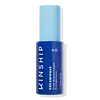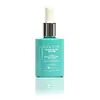What's inside
What's inside
 Key Ingredients
Key Ingredients

 Benefits
Benefits

 Concerns
Concerns

 Ingredients Side-by-side
Ingredients Side-by-side

Water
Skin ConditioningGlycerin
HumectantSqualane
EmollientCaprylic/Capric Triglyceride
MaskingCoconut Alkanes
EmollientAloe Barbadensis Leaf Juice
Skin ConditioningCetearyl Olivate
Sorbitan Olivate
EmulsifyingChlorella Vulgaris Extract
Skin ConditioningButyrospermum Parkii Nut Extract
EmollientCetyl Palmitate
EmollientSorbitan Palmitate
EmulsifyingDipropylene Glycol
HumectantPropanediol
SolventTranexamic Acid
AstringentPhenoxyethanol
PreservativeSodium Palmitoyl Proline
Skin ConditioningCaprylyl Glycol
EmollientCarbomer
Emulsion StabilisingCoco-Caprylate/Caprate
EmollientEthylhexylglycerin
Skin ConditioningHexylene Glycol
EmulsifyingTocopherol
AntioxidantSodium Phytate
Niacinamide
SmoothingButylene Glycol
HumectantOlea Europaea Leaf Extract
PerfumingDicaprylyl Ether
EmollientSafflower Seed Oil Piperonyl Esters
Skin ConditioningSodium Hyaluronate
HumectantLecithin
EmollientLavandula Angustifolia Oil
MaskingCitrus Paradisi Peel Oil
MaskingAniba Rosaeodora Wood Oil
AstringentRetinal
Skin ConditioningCamellia Sinensis Leaf Extract
AntimicrobialPentylene Glycol
Skin ConditioningLactic Acid
BufferingNymphaea Alba Flower Extract
Skin ConditioningLactobacillus Ferment
Skin ConditioningCitric Acid
BufferingSodium Benzoate
MaskingPotassium Sorbate
PreservativeSodium Hyaluronate Crosspolymer
HumectantSodium Hydroxide
BufferingLinalool
PerfumingLimonene
PerfumingWater, Glycerin, Squalane, Caprylic/Capric Triglyceride, Coconut Alkanes, Aloe Barbadensis Leaf Juice, Cetearyl Olivate, Sorbitan Olivate, Chlorella Vulgaris Extract, Butyrospermum Parkii Nut Extract, Cetyl Palmitate, Sorbitan Palmitate, Dipropylene Glycol, Propanediol, Tranexamic Acid, Phenoxyethanol, Sodium Palmitoyl Proline, Caprylyl Glycol, Carbomer, Coco-Caprylate/Caprate, Ethylhexylglycerin, Hexylene Glycol, Tocopherol, Sodium Phytate, Niacinamide, Butylene Glycol, Olea Europaea Leaf Extract, Dicaprylyl Ether, Safflower Seed Oil Piperonyl Esters, Sodium Hyaluronate, Lecithin, Lavandula Angustifolia Oil, Citrus Paradisi Peel Oil, Aniba Rosaeodora Wood Oil, Retinal, Camellia Sinensis Leaf Extract, Pentylene Glycol, Lactic Acid, Nymphaea Alba Flower Extract, Lactobacillus Ferment, Citric Acid, Sodium Benzoate, Potassium Sorbate, Sodium Hyaluronate Crosspolymer, Sodium Hydroxide, Linalool, Limonene
Water
Skin ConditioningMethylpropanediol
SolventAscorbic Acid
AntioxidantPropylene Glycol
HumectantPolysorbate 20
EmulsifyingGlycerin
HumectantLaureth-23
CleansingKojic Acid
AntioxidantAlpha-Arbutin
AntioxidantAzelaic Acid
BufferingButylene Glycol
HumectantCamellia Sinensis Leaf Extract
AntimicrobialCitrus Aurantium Dulcis Peel Oil
MaskingDiethanolamine
BufferingEthoxydiglycol
HumectantEuterpe Oleracea Fruit Extract
Ferulic Acid
AntimicrobialGlutathione
Niacinamide
SmoothingPanthenol
Skin ConditioningPhenoxyethanol
PreservativeRetinyl Palmitate
Skin ConditioningSodium Hyaluronate
HumectantTocopherol
AntioxidantTriethanolamine
BufferingWater, Methylpropanediol, Ascorbic Acid, Propylene Glycol, Polysorbate 20, Glycerin, Laureth-23, Kojic Acid, Alpha-Arbutin, Azelaic Acid, Butylene Glycol, Camellia Sinensis Leaf Extract, Citrus Aurantium Dulcis Peel Oil, Diethanolamine, Ethoxydiglycol, Euterpe Oleracea Fruit Extract, Ferulic Acid, Glutathione, Niacinamide, Panthenol, Phenoxyethanol, Retinyl Palmitate, Sodium Hyaluronate, Tocopherol, Triethanolamine
 Reviews
Reviews

Ingredients Explained
These ingredients are found in both products.
Ingredients higher up in an ingredient list are typically present in a larger amount.
Butylene Glycol (or BG) is used within cosmetic products for a few different reasons:
Overall, Butylene Glycol is a safe and well-rounded ingredient that works well with other ingredients.
Though this ingredient works well with most skin types, some people with sensitive skin may experience a reaction such as allergic rashes, closed comedones, or itchiness.
Learn more about Butylene GlycolCamellia Sinensis Leaf Extract is derived from the leaves of the tea plant. Black tea, green tea, and oolong tea are all harvested from this plant.
This ingredient has many skin benefits:
This ingredient contains polyphenols, a strong antioxidant. Antioxidants help fight off molecules that damage skin cells.
On top of that, the antioxidants in green tea neutralize free-radicals from the sun. This gives the skin some extra UV protection, but should not replace sunscreen.
Many components of tea have anti-inflammatory properties.
Polyphenols and L-theanine help soothe the skin and reduce irritation. The caffeine in Camellia Sinensis Leaf Extract helps calm inflamed blood vessels.
Other compounds found in tea include: Vitamin Bs, linoleic acid, magnesium, calcium, iron, and zinc.
Research has shown both drinking Camellia Sinensis Leaf Tea and applying it to the skin can help boost skin elasticity and hydration. Studies also show using tea extract may reduce sebum, or oil, production.
Learn more about Camellia Sinensis Leaf ExtractGlycerin is already naturally found in your skin. It helps moisturize and protect your skin.
A study from 2016 found glycerin to be more effective as a humectant than AHAs and hyaluronic acid.
As a humectant, it helps the skin stay hydrated by pulling moisture to your skin. The low molecular weight of glycerin allows it to pull moisture into the deeper layers of your skin.
Hydrated skin improves your skin barrier; Your skin barrier helps protect against irritants and bacteria.
Glycerin has also been found to have antimicrobial and antiviral properties. Due to these properties, glycerin is often used in wound and burn treatments.
In cosmetics, glycerin is usually derived from plants such as soybean or palm. However, it can also be sourced from animals, such as tallow or animal fat.
This ingredient is organic, colorless, odorless, and non-toxic.
Glycerin is the name for this ingredient in American English. British English uses Glycerol/Glycerine.
Learn more about GlycerinNiacinamide is a multitasking form of vitamin B3 that strengthens the skin barrier, reduces pores and dark spots, regulates oil, and improves signs of aging.
And the best part? It's gentle and well-tolerated by most skin types, including sensitive and reactive skin.
You might have heard of "niacin flush", or the reddening of skin that causes itchiness. Niacinamide has not been found to cause this.
In very rare cases, some individuals may not be able to tolerate niacinamide at all or experience an allergic reaction to it.
If you are experiencing flaking, irritation, and dryness with this ingredient, be sure to double check all your products as this ingredient can be found in all categories of skincare.
When incorporating niacinamide into your routine, look out for concentration amounts. Typically, 5% niacinamide provides benefits such as fading dark spots. However, if you have sensitive skin, it is better to begin with a smaller concentration.
When you apply niacinamide to your skin, your body converts it into nicotinamide adenine dinucleotide (NAD). NAD is an essential coenzyme that is already found in your cells as "fuel" and powers countless biological processes.
In your skin, NAD helps repair cell damage, produce new healthy cells, support collagen production, strengthen the skin barrier, and fight environmental stressors (like UV and pollution).
Our natural NAD levels start to decline with age, leading to slower skin repair, visible aging, and a weaker skin barrier. By providing your skin niacinamide, you're recharging your skin's NAD levels. This leads to stronger, healthier, and younger looking skin.
Another name for vitamin B3 is nicotinamide. This vitamin is water-soluble and our bodies don't store it. We obtain Vitamin B3 from either food or skincare. Meat, fish, wheat, yeast, and leafy greens contain vitamin B3.
The type of niacinamide used in skincare is synthetically created.
Learn more about NiacinamidePhenoxyethanol is a preservative that has germicide, antimicrobial, and aromatic properties. Studies show that phenoxyethanol can prevent microbial growth. By itself, it has a scent that is similar to that of a rose.
It's often used in formulations along with Caprylyl Glycol to preserve the shelf life of products.
Sodium Hyaluronate is hyaluronic acid's salt form. It is commonly derived from the sodium salt of hyaluronic acid.
Like hyaluronic acid, it is great at holding water and acts as a humectant. This makes it a great skin hydrating ingredient.
Sodium Hyaluronate is naturally occurring in our bodies and is mostly found in eye fluid and joints.
These are some other common types of Hyaluronic Acid:
Learn more about Sodium HyaluronateTocopherol (also known as Vitamin E) is a common antioxidant used to help protect the skin from free-radicals and strengthen the skin barrier. It's also fat soluble - this means our skin is great at absorbing it.
Vitamin E also helps keep your natural skin lipids healthy. Your lipid skin barrier naturally consists of lipids, ceramides, and fatty acids. Vitamin E offers extra protection for your skin’s lipid barrier, keeping your skin healthy and nourished.
Another benefit is a bit of UV protection. Vitamin E helps reduce the damage caused by UVB rays. (It should not replace your sunscreen). Combining it with Vitamin C can decrease sunburned cells and hyperpigmentation after UV exposure.
You might have noticed Vitamin E + C often paired together. This is because it is great at stabilizing Vitamin C. Using the two together helps increase the effectiveness of both ingredients.
There are often claims that Vitamin E can reduce/prevent scarring, but these claims haven't been confirmed by scientific research.
Learn more about TocopherolWater. It's the most common cosmetic ingredient of all. You'll usually see it at the top of ingredient lists, meaning that it makes up the largest part of the product.
So why is it so popular? Water most often acts as a solvent - this means that it helps dissolve other ingredients into the formulation.
You'll also recognize water as that liquid we all need to stay alive. If you see this, drink a glass of water. Stay hydrated!
Learn more about Water